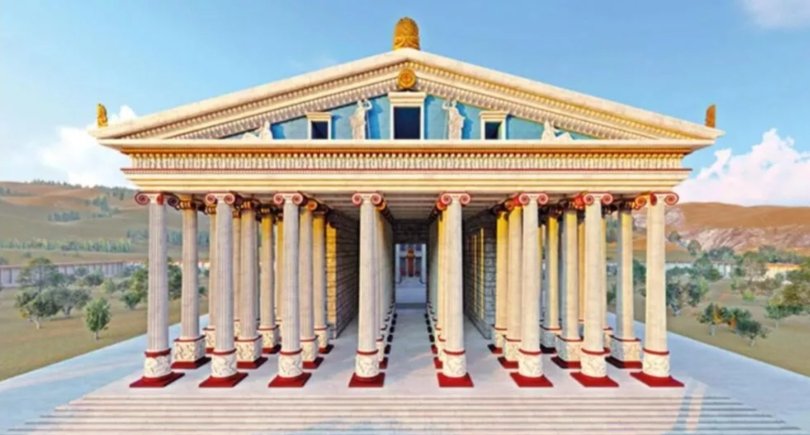The Vision Unfulfilled: Alexander the Great and the Unbuilt City on Mount Athos
In the annals of history, few figures loom as large as Alexander the Great, whose conquests reshaped the ancient world. Equally ambitious were his architectural and urban projects, which aimed to immortalize his legacy in stone and mortar. Among the most intriguing of these was a proposal to construct a city on Mount Athos in Greece (now an important center of Eastern Orthodox monasticism). The story of why this project was abandoned offers a fascinating glimpse into the practical considerations that underpinned even the grandest visions of antiquity.
Deinokrates the Rhodian, a renowned architect of the 4th century BC and a technical advisor to Alexander, is known for his significant contributions to ancient architecture. His works include the planning of Alexandria, the funeral pyre of Hephaestion, and the reconstruction of the Temple of Artemis at Ephesus. However, his proposal for a city on Mount Athos stands out for its audacity and the rationale behind its rejection.
The Proposal
When Alexander sought a location for a new city that would bear his name and reflect his greatness, Deinokrates proposed Mount Athos, a site known for its majestic natural beauty and strategic location. The plan was not merely to build a city but to carve Alexander's effigy into the mountain, creating a monument of unparalleled scale. This effigy would depict Alexander holding a city in one hand and pouring water from a bottle with the other, symbolizing his dominion over both land and sea.
In the only surviving architectural treatise from antiquity, Vitruvius mentions Deinokrates for conceptualizing the carving of one side of Mount Athos with the colossal effigy of Alexander the Great embracing a small town (10,000 residents) with one hand, holding a bottle with the other, and pouring water into a river while touching the sea with his feet.
"I," he said, "have thought, O King, to entrust the image of your body to an incorruptible and living substance, which has eternal foundations and an immovable and unshakable weight. This is Mount Athos in Thrace, where it has its greatest volume and rises most prominently and has a symmetrical height and width and rocky areas and intervals of some form. Athos is strong in the art of processing and transformation, it shall be called Alexander's statue and be his true statue, which will touch the sea with his feet, embrace and support with one hand a city that can hold 10,000 inhabitants. With his right hand holding a bottle, he shall pour libations over the entire river that flows ceaselessly and pours into the sea in honor of the gods. Let’s abandon the idea of the gold and the copper and the ivory and the wooden and colored works, which are easily stolen."
The Rejection
Alexander's decision to abandon this grandiose plan was rooted in practicality. Deinokrates, for all his architectural genius, had overlooked the essential needs of the city's future inhabitants. The rugged terrain of Mount Athos was unsuitable for agriculture, making it impossible to grow grain or sustain a population. All necessities would have to be transported by sea, a logistical challenge that would undermine the city's viability. In contrast, the site chosen for Alexandria in Egypt offered fertile land, access to the Mediterranean, and the potential for a thriving urban center.
The Legacy of Deinokrates
Despite the non-realization of the Athos project, Deinokrates's legacy is cemented through his other works. Alexandria, in particular, stands as a testament to his vision, with its innovative grid layout, sophisticated water supply, and drainage systems. These contributions exemplify the blend of artistic vision and engineering prowess that characterized Hellenistic urban planning.
Deinocrates, in collaboration with Paionius and Demetrius, rebuilt the Temple of Artemis, one of the Seven Wonders of the Ancient World, which had been destroyed by Herostratus on July 21, 356 BC, the day on which, it is said, Alexander the Great was born.
Reflections
The tale of the unfinished city on Mount Athos serves as a reminder that even in antiquity, practical considerations limited the most ambitious plans. Alexander's empire was built on the twin pillars of visionary ambition and pragmatic governance. The decision to prioritize the needs of his people over architectural marvels reflects a leader who understood the importance of sustainable development.
Moreover, Deinokrates's proposal, though never realized, speaks to the human desire to leave a lasting mark on the world. The project envisioned for Mount Athos was not just an architectural endeavor but a symbol of the intersection between nature, divinity, and human achievement. It encapsulates a moment when ambition brushed against the limits of feasibility, leaving behind a tale that continues to inspire and caution future generations.
In September 2015, after the presentation of the results of the excavation team of the Kasta Tomb based on the research carried out from 2012 to 2014, it was announced that the monument was built by order of Alexander the Great, and the builder was Deinokratis.
In sum, the unbuilt city on Mount Athos serves as a poignant narrative of ambition, practicality, and the enduring quest for immortality through architecture. It reminds us that history is not just a record of what was built but also of what could have been, offering lessons that resonate far beyond the ancient world.











